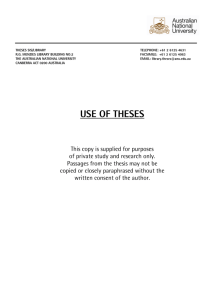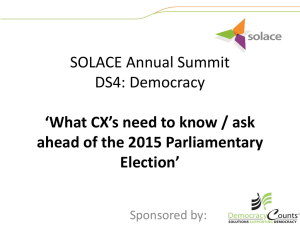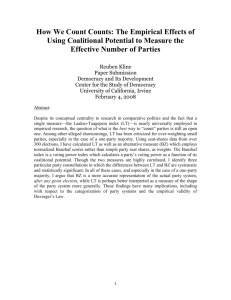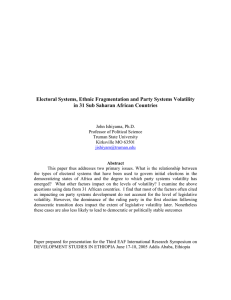Spanish Political Parties
advertisement
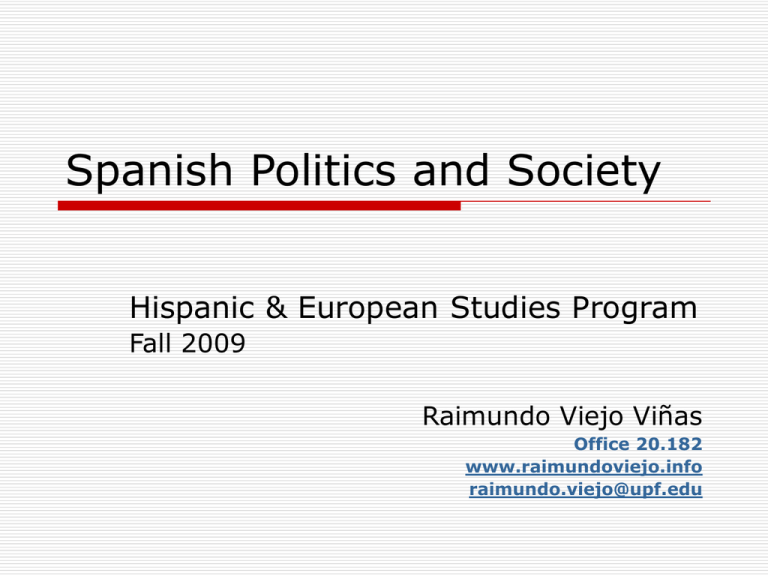
Spanish Politics and Society Hispanic & European Studies Program Fall 2009 Raimundo Viejo Viñas Office 20.182 www.raimundoviejo.info raimundo.viejo@upf.edu Institutions of Spanish Democracy, 1 Political parties and party system What’s a political party? A political party is a group of people that is organised for the purpose of winning government power by electoral (or other) means. Political parties as such: … aim to exercise government power by winning political office … are organised bodies with a formal membership … adopt a broad issue focus, addressing each area of government policy … are united by shared political preferences Main functions of political parties Representation Elite formation and recruitment Goal formulation Interest articulation and aggregation Socialization and mobilization Organization of government Types of political parties Caucus parties (elite parties) and mass parties Catch-all parties and electoral-professional parties Media parties and Cartel parties Post-materialist parties (green parties, animal rights parties, etc) Government Formation: Parliamentary Systems Party system Assembly Government One-party Dominant One-party majority Dominant party government – Japan, Sweden, South Africa Two-party system One-party majority or near-majority One-party government with swings between the two main parties – Greece, Norway, Spain, UK. Multi-party systems Multi-party assemblies Coalition government Spanish Political Parties Left-right cleavage (socio-economic dimension) Partido Socialista Obrero Español, PSOE (center-left wing party) Partido Popular, PP (right-wing party) Izquierda Unida, IU (federation of left-wing parties) Centre-periphery cleavage (territorial dimension) Convergència i Unió (Catalan liberal and christiandemocratic coalition) Euzko Alderdi Jeltzalea (Basque christian-democratic party) Esquerra Republicana de Catalunya (Catalan proindependence party) Bloque Nacionalista Galego (Galician nationalist coalition) Coalición Canaria, Chunta Aragonesista, and others. Centre-right party positions Party 1979 1982 1986 1989 1993 1996 2000 2004 AP/PP 7.92 8.50 8.47 8.20 8.23 7.94 7.43 7.77 PSOE 3.90 3.56 3.78 4.29 4.17 4.52 4.28 4.27 PCE/IU 2.50 1.87 2.08 2.26 2.37 2.52 2.45 2.43 Spanish party system, 1 Spanish democratic elections can be separated in four different phases: 1977 and 1979 founding elections (UCD governments) 1982-1989 Socialist absolute majorities (sudden disappearance of the UCD) 1993-2008 Conservatives and Socialists alternating majorities Spanish Party system Main features of Spanish party system Electoral volatility Party-system fragmentation Governability and competitiveness Moderation Electoral volatility Electoral Volatility Years Total Volatility Intrabloc Volatility Interbloc Volatility 1977-1979 10.8 8.6 2.2 1979-1982 42.3 35.6 6.7 1982-1986 11.9 9.5 2.4 1986-1989 8.9 7.2 1.7 1989-1993 9.5 7.8 1.7 1993-1996 4.4 2.7 1.7 1996-2000 10.1 2.7 7.4 Party-system fragmentation Effective Number of Parties Years Electoral Parliamentary 1977 4.45 2.89 1979 4.29 2.81 1982 3.20 2.33 1986 3.59 2.68 1989 4.09 2.85 1993 3.47 2.67 1996 3.21 2.72 2000 3.02 2.48 Governability and competitiveness Electoral and Parliamentary Competitiveness Years Electoral Parliamentary Parties 1977 5.2 13.9 UCD-PSOE 1979 4.5 13.4 UCD-PSOE 1982 21.9 27.1 PSOE-AP 1986 18.3 22.6 PSOE-AP 1989 14.0 19.4 PSOE-PP 1993 4.0 5.1 PSOE-PP 1996 1.3 4.3 PP-PSOE 2000 10.5 16.6 PP-PSOE



